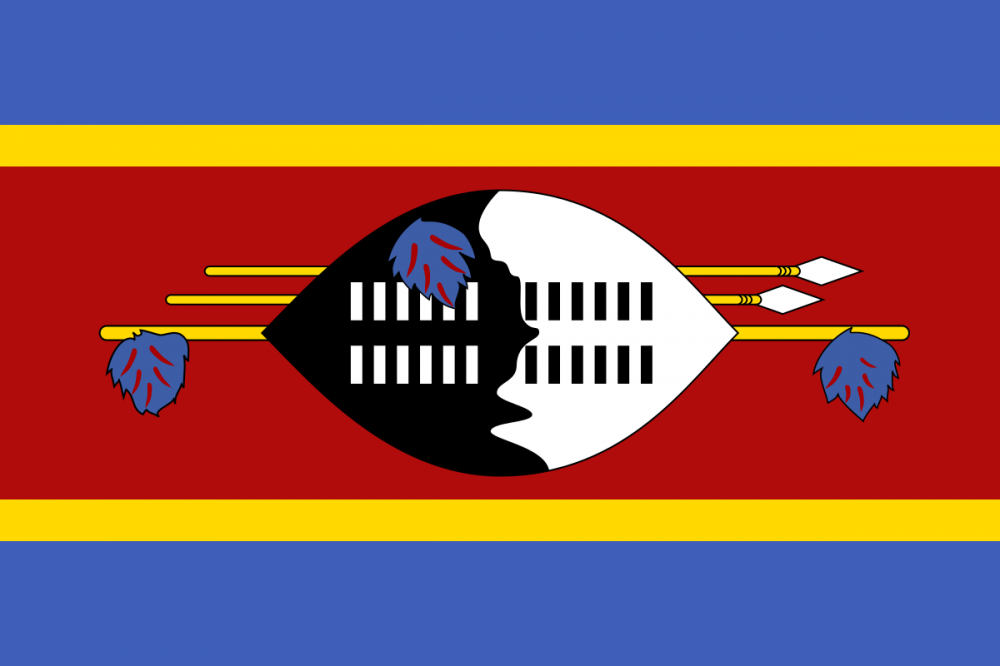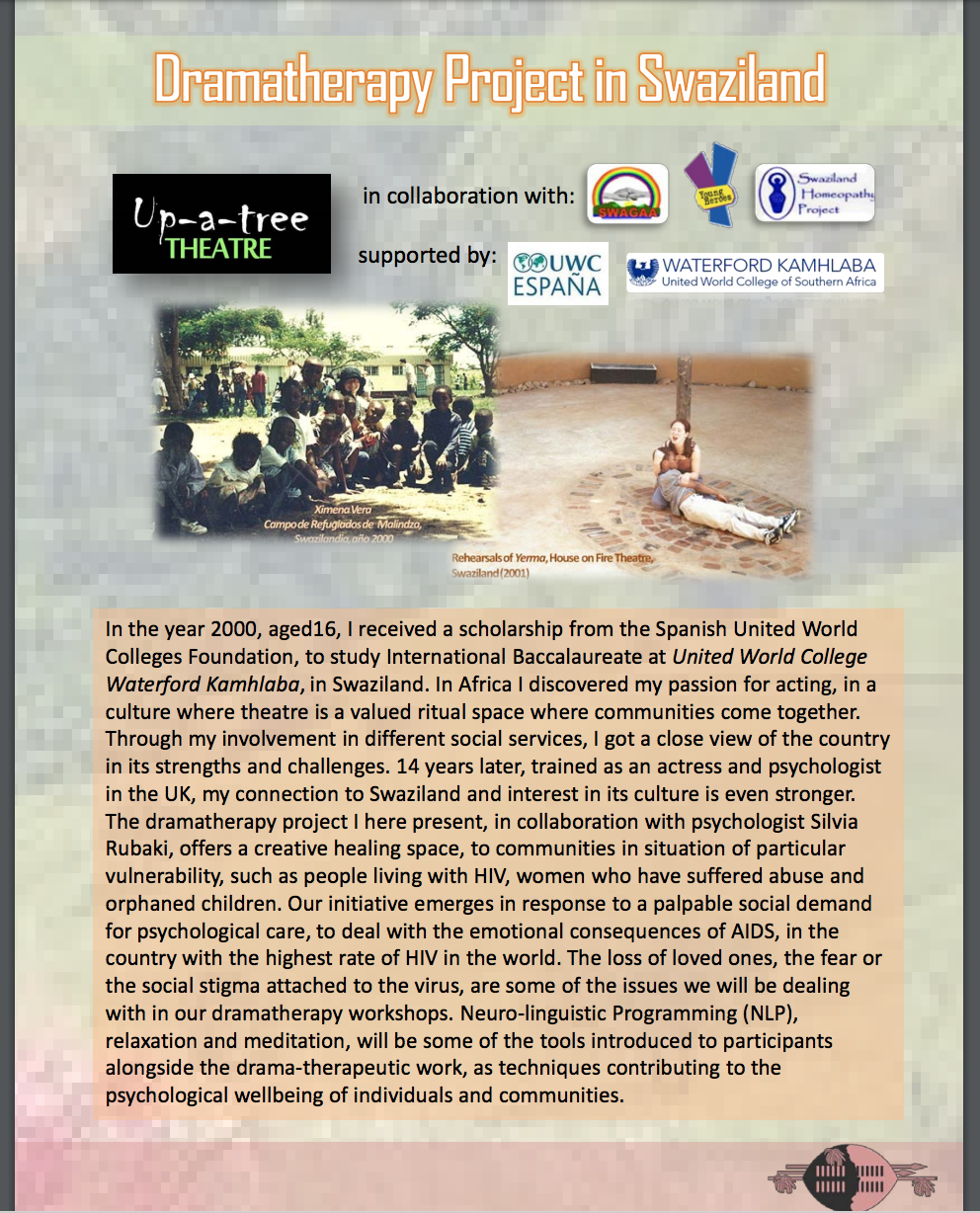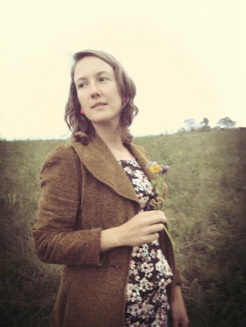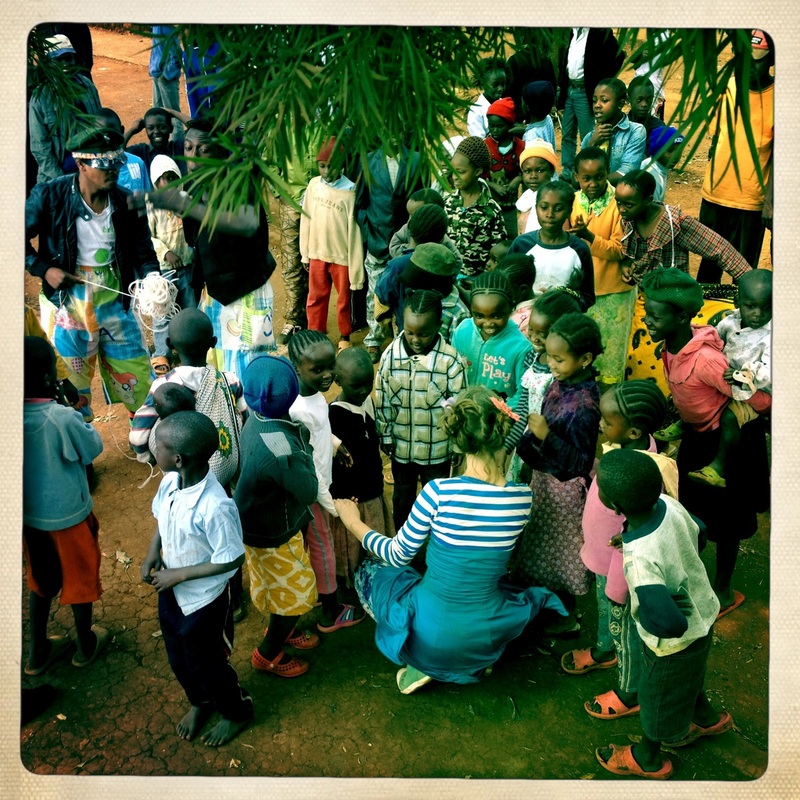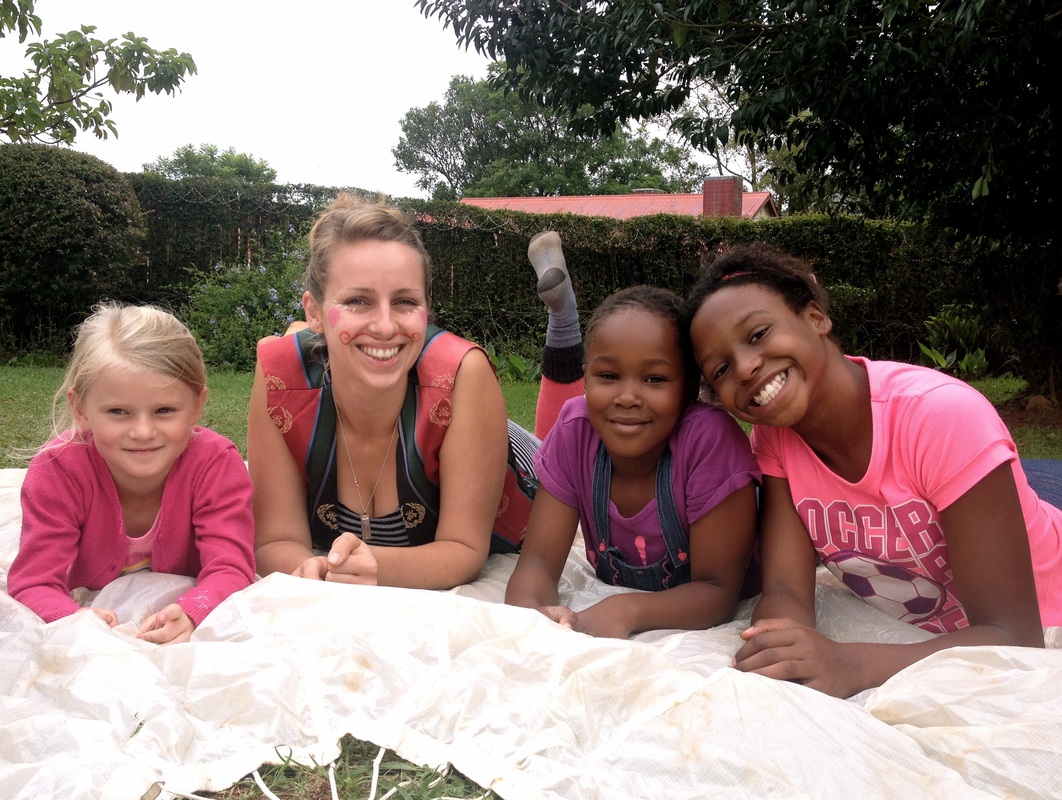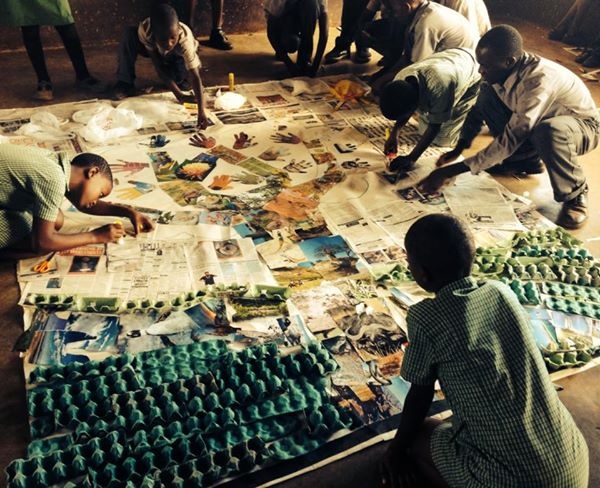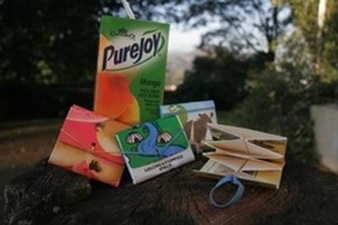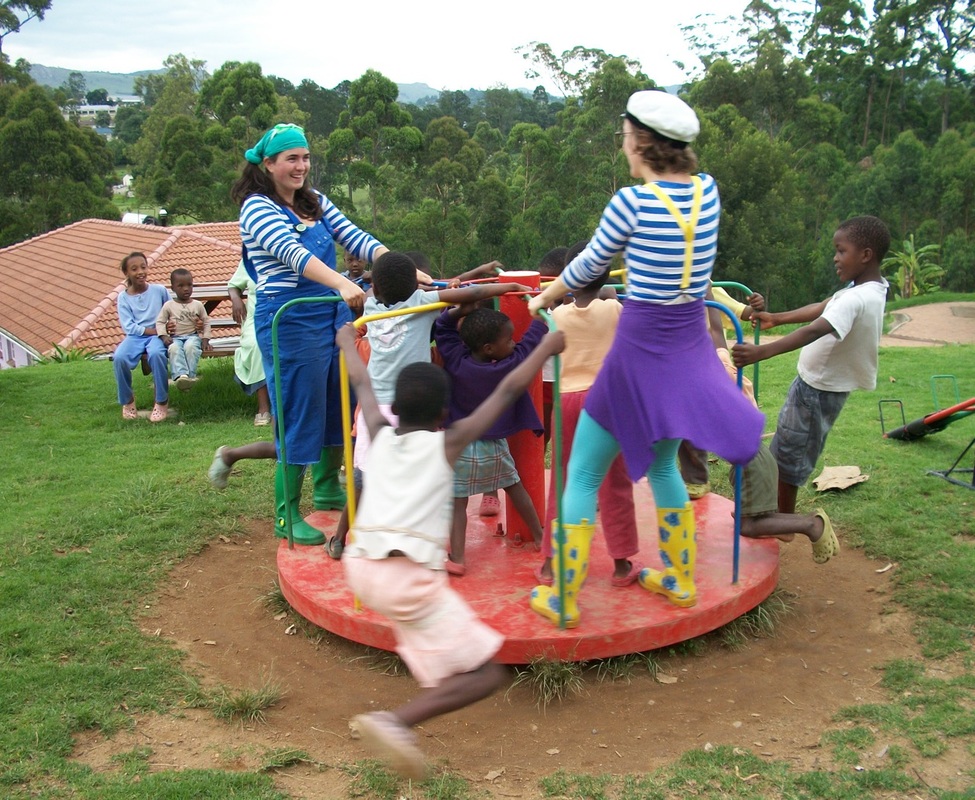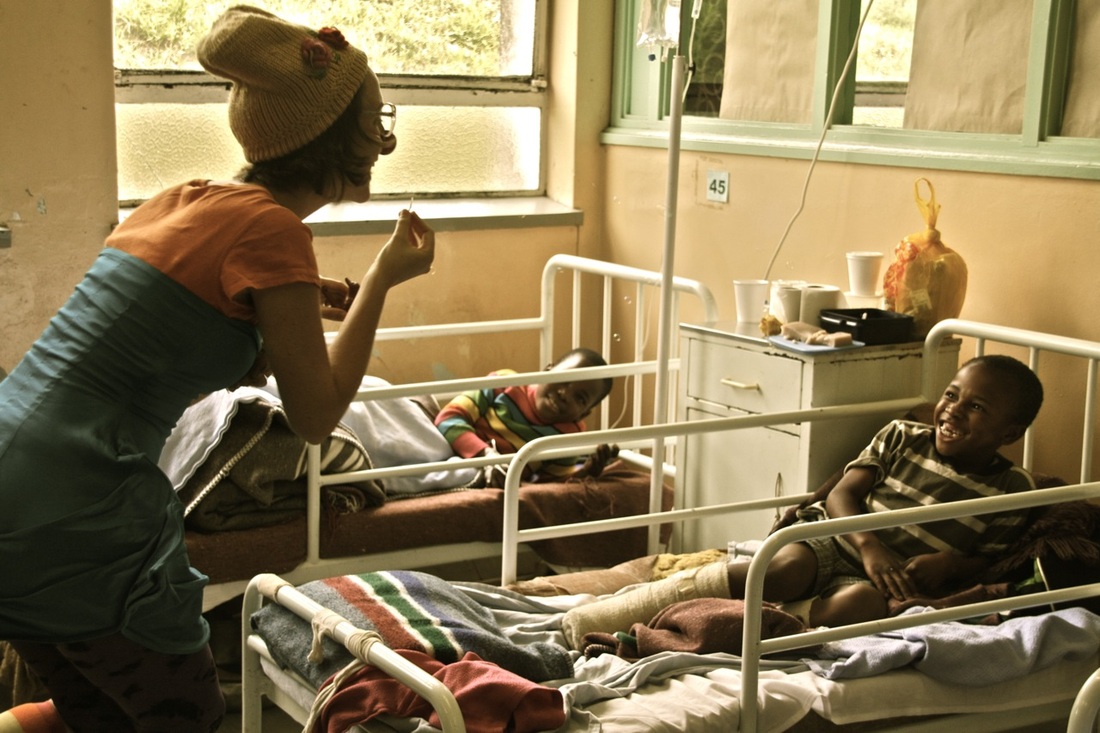Full document here: http://www.up-a-treetheatre.com/wp-content/uploads/2014/04/DramaSwazi.pdf
Swazi Theatre Groups: Iphi Africa
The Prince Claus Fund supports the theatre play A Drop in the Land, a fruitful co-production between Swaziland’s Iphi Africa and South Africa’s Laway Arts. According to the director Nelson Mapako’s credo “don’t tell but show” in a synergy between movements, puppets, music and dance young actors and dancers let a story unfold about young people’s daily worries and pursuits.

“where is africa”
The theatre production is directed by Nelson Mapako and Macebo Mavuso. Mapako initiated the theatre group Iphi Africa (literally “Where is Africa”) a few years ago, enabling young actors and dancers to explore the art of dance and drama while tackling the challenges of Africa. With this project he has provided Swaziland with a welcome platform for artistic talents to assemble, develop and express themselves. His co-producer’s team, Laway Arts, meaning “flexibility,” is a Dutch-South African initiative which cultural activities cut across countries and cultures. The collaboration between Mapako and Mavuso, who is a professional and internationally operating actor, puppet player and musician, might function as artistic impulse for Swaziland, which theatre industry is still in its infancy. Artistic initiatives employed here encounter many obstacles, due to a lack of facilities and governmental support and the underdeveloped condition of professional theatre companies and art education. A theatre co-production with Laway Arts brings in professional artistic skills, experience and knowledge and moreover breaks through the isolated position of Swaziland’s art practice. Both directors are convinced that Swaziland’s future theatre development and production will reap the fruits from A Drop in the Land.
background information
A Drop in the Land tours through the rural areas of Swaziland, with this country’s fast-growing early summer Bush Fire Festival as a highlight. Apart from this it will be performed in Zimbabwe and, importantly, during South Africa’s largest cultural event, the Grahamstown Festival,. For a local, informal theatre group from isolated Swaziland, which usually has merely a self-built township theatre at its disposal, producing a theatre play in professional setting and for a broad, international audience is a unique opportunity. It allows Mapako’s
group not only to promote a hitherto unknown and neglected field of art throughout rural Swaziland, but also to export this country’s culture outside its usually very closed borders, enabling artists to interact with colleagues from different parts of the world. Expecting it to sow the seeds of future international collaboration and professionalization of Swaziland’s theatre scene, the directors are convinced that with A Drop in the Land Swaziland’s secret source of tradition, culture and creative spirit will not run dry.
Source:
- http://www.princeclausfund.org/en/activities/a-welcome-drop-in-swaziland.html
Swazi Theatre Groups: Kasi Theatre
***
Times of Swaziland article:
THEATRE FINALLY REACHES RURAL CHILDREN
MBABANE – The World Day of Theatre for Children and Young People, which officially falls on March 20, was commemorated last Sunday at Nsukumbili community, under Dlangeni Inkhundla.
The event, which was attended by over 200 people, was organised by Kasi Theatre Productions, and supported by the Baphalali Swaziland Red Cross Society.
Addressing the gathering, Kasi Theatre director Clifford Ndlovu, said children’s theatre in the country needs to be developed from the grassroots, in order to instil a culture of active arts in the youth.
“That is why this year we decided to bring the commemorations to a rural community, having held the past events in the big cities. Both rural and urban children should be exposed equally to the opportunities that theatre presents. We hope the community will encourage their children and the youth to actively participate in several arts initiatives, as arts have been proven to provide effective social grooming of children,” reasoned Ndlovu.
Ndlovu said the commemorations were part of the International Association of Theatre for Children and Young People (ASSITEJ) organisation’s activities, which this year celebrates 50 years of existence.
“ASSITEJ exists to build the field of theatre for young audiences in every country of the world. It does this through linking members into national centres, into regional networks and into the wider ASSITEJ membership for international exchange. It provides through its programmes and activities, which include publication, promotion, research, networking, artistic exchange, mentorship and development, opportunities for the field of theatre for young audiences to become stronger and more effective,” explained Ndlovu.
Source:
- http://www.pressreader.com/swaziland/swazi-observer/20150505/282840779608203
- http://www.times.co.sz/entertainment/107137-theatre-finally-reaches-rural-children.html
Swazi Theatre Groups: Creative Beans
WHO THEY ARE
Annabel has performed, facilitated, directed and co-ordinated projects for CWB in Swaziland, South Africa, Kenya, South Sudan, Zimbabwe, Botswana, Lithuania and Sweden.
Having trained with Raudonos Nosys in Lithuania, Creative Beans regularly sends Banana into the government hospitals in Swaziland (and any visiting clown doctors too). Banana has also visited Cheshire Homes, the only rehabilitative centre for children living with disabilities in Swaziland, bringing laughter and smiles to children and their families. Contact Creative Beans to find out more.
In the past, the following schools in Swaziland have offered Creative Beans drama as an extra-curricular activity: International Montessori, Panorama Montessori, Sifundzani Primary, Montessori Life, Care Bears pre-school and Waterford KaMhlaba United World College.
Voice and performance coaching by Annabel Morgan
With its tribal rhythms, great melodies and positive message of peace and goodwill, The Peace Child was a colourful and vibrant Christmas show performed by 120 Grade 1 and 2 children at Sifundzani Primary.
Directed by Annabel Morgan.
Creative Beans is dedicated to inspiring creative thinking for sustainable living.
Water 4 All Sanitation Project
Tetrapak Wallets: An environmentally quirky way to store your money and cards!
The wallets provide inspiration to think creatively and see economic potential in what is usually regarded as waste.Each wallet is made from a recycled carton so quality may differ. Each wallet also had a life of its own before becoming a wallet. Imagine the stories it could tell. Inside each wallet you will find a 5c Swazi coin as a symbol of good luck. May prosperity flow with ease and abundance!
In Swaziland there is currently little emphasis on the arts in primary school curriculum or encouragement of creative thinking and expression. Even more so for those children who are unable to go to school. Creative Beans is dedicated to lighting the creative fire within disadvantaged communities.
Creative Beans projects have ranged from writing and directing plays at Neighbourhood Care Points to visiting children’s homes and hospitals as a clown.
- http://creativebeans.weebly.com/
Bush Fire Festival – Music and Performing Arts Festival
Summer Theatre Festivals Around the World
May 13, 2014 — NICK REICHERT
Whether you’re traveling across the pond or across the street this summer, make sure you check out our annual listing of more than 200 theatre festivals worldwide.
Swaziland
Bushfire, Ezulwini Valley; www.bush-fire.com; May 30-Jun 1.
With 100 percent of its profits donated to local orphan and community-development charities, the Bush Fire Festival delights in the positive effects of the creativity of the human spirit. A parade of arts (including music, theatre, poetry, dance and circus performance) fuse together into three days of gleeful expression. The Talking Doors exhibit (pictured) defines Bush Fire’s desire for artistic collaboration by allowing festival goers to interact in a structure made out of walls composed of dozens of doors.
***
Five International Theatre Collaborations You Should Know
April 11, 2014 — NICOLE ESTVANIK TAYLOR
From festivals to interdisciplinary collaboration, from Brazil to Swaziland, each of these locations offers something unique.
Malkerns, Swaziland
Bushfire: The vibrant performance venue and gallery House on Fire was created in 2000 by Jiggs Thorne in his native Swaziland, on farmland his family has converted into a center of tourism (the complex, Malandela, also contains a B&B, restaurant, botanical garden and handicraft business). House on Fire has attracted headline musical talent and become a haven for local sculptors and artisans, as well as a destination for public school groups that lack a formal arts curriculum. In 2007 Thorne inaugurated House on Fire’s Bushfire Festival. The venue already boasted an amphitheatre seating several hundred and a lawn that can host concerts for thousands. In 2012 Thorne added the Barn, an intimate space for performance art, exhibitions, speakers, and roundtable discussions.
Sponsored by telecommunications company MTN, the Bushfire Festival now maxes out its capacity at 20,000 visitors over the course of three days. An estimated 65 percent of that audience is Swazi, but 2013 festival surveys indicate visitors came from some 30 countries. And the momentum continues: Bushfire reached out last year to form Firefest, a southern African festival circuit, with four partners: Harare International Festival of Arts in Zimbabwe, the Azgo Festival in Mozambique, the BlackMajor Festival in South Africa and the Sakifo Musik Festival on the island of Réunion. All five events have been coordinated to take place during May and June, which encourages artists from Africa and abroad to tour the entire route (and enables the venues to share presenting costs).
Music is Bushfire’s driving force, but theatre has its place too. Three of seven editions so far have featured Gcina Mhlophe—a South African activist, poet and storyteller who performs in English, Afrikaans, Zulu and Xhosa—and last year the South African father-and-daughter duo Ellis and Céire Pearson performed a play about drought titled Catch the Rain. At press time, Thorne was in the process of securing one or more theatrical performances for 2014. He says he looks for broad appeal across generations and cultures and “an emphasis on relevant sociopolitical and environmental-based topics.” In that same vein of social responsibility, Bushfire divides its profits between a Swazi NGO for orphans called Young Heroes, and a nonprofit called Gone Rural boMake that runs water, health and education programs for female artisans. (May 30–June 1; www.bush-fire.com)
Sources:
- http://www.americantheatre.org/2014/04/11/five-international-theatre-collaborations-you-should-know/
- http://www.americantheatre.org/2014/05/13/summer-theatre-festivals-around-the-world-2/3/
Ministry of Sports, Culture and Youth Affairs
Arts & Culture
The Swaziland National Council of Arts and Culture, is an administrative organization, under the Ministry of Sports Culture and Youth Affairs, with delegated powers, to Preserve, Promote and Co-Ordinate all matters of Arts and Culture, in the Kingdom, of Swaziland, supervised by the Directorate Office under the Ministry.
***
The Council has as members, the different art codes under its umbrella, specializing in the different art codes, namely:
• The Performing Arts (Music, Theatre, Dance & Beauty Pageants)
• Visual Arts ( Fine Arts, Craft, film & Television)
• Literary Arts ( Book Writing and Publication)
Council
1. The Association of Swaziland Theatre Groups ( ASTG)
2. Association of Christian Artists of Swaziland ( ACASWA)
3. Swaziland Arts and Music Association ( SWAMA)
4. Independent Producers Association( IPAS)
5. Imigidvo Yesintfu KaNgwane
6. Swaziland National Umbholoho Association (SNUA)
7. Swaziland Traditional Instruments Players Music Association ( STIMA)
8. Swaziland Schools Culture Association (SSCA)
9. Swaziland Beauty Pageant Association ( SBPA)
10. Swaziland Visual Arts Network ( VANS)
11. Umdlandla Writers and Authors Association)
12. Beading Association
13. Pottery Association
14. Craft Association
15. Sculptures
16. Painters
17. Designers
18. Weavers
Source: http://www.gov.sz/index.php?option=com_content&view=article&id=373&Itemid=358
Famous Venues
House on Fire
“House On Fire was founded by brothers Jiggs and Sholto Thorne in 2000. Both possessing a passionate love of art and music, the Thornes decided to create a space to grow and develop the arts in Swaziland. Thus began the initial conceptualisation of House on Fire.
Inspired by unique outsider creation environments, the likes of the Owl House in Neiu Bethesda and the Rock Garden in Chandigarh, India, House On Fire is embellished with symbols and icons from around the world highlighting the ideology of harmony in contrast.
The initial theatre space was designed in collaboration with architect Sarah Calburn. Since then it has evolved into a multi-functional and expanding creative space. Many talented artisans and crafters from across the Kingdom have added their magic and contributed to the continuous evolution that have become House On Fire, Malandela’s and the surrounding gardens and outside areas. Artist of note, Noah Mduli, has been a significant contributor to the soap stone sculptures inside the theatre and beyond into the gardens.
The brothers’ combined business talents have seen the venue evolve and thrive. Visionary art and programme direction combined with outstanding technical and logistical planning has been the key to House On Fire’s running success.”
Swaziland Theatre Club
“Founded in 1963 by Peter Bellenden… a year later the clubhouse was open. 1968 was the year when the theatre was erected thus becoming the idle place to spend your leisure time and there after , in 1971 the clubhouse workshop was opened. The theatre club still remains the one and only THEATRE (not cinema) in the country and thus making it a valuable treasure to the Kingdom.”
Sources:
- http://www.house-on-fire.com/#
- Swaziland Theatre Club Facebook Page
History of “theatre” in Swaziland

Theatre has been in Swaziland for a long time. It started out historically as cultural forms of storytelling through theatrical dance, including Sibhaca, Ummiso, Lutsango and others.
Sibhaca dancing is very vigorous and is performed by teams of men throughout Swaziland. It involves the stomping of feet in unison to rhythmic chants and traditional music while the men wear colorful quilts and decorate their legs with mohair implements.
Ummiso is a Swazi traditional dance performed by young unmarried girls. It is a form of play, celebration of beauty, revelling in youth and sisterhood, and a playful teasing of and competition with the men. It is also in celebration of the King and of the abundance of the fruits of the land. This tradition is rooted in the grand Swazi tradition of Umhlanga (the reed dance).
Lutsango is a dance performed by older and married Swazi women, more demure but more elegant.
Then,during colonial times, theatre in Swaziland was driven by a strong need for entertainment as well as a strong literary tradition. Colonial theatre was normally performed by expats who needed a pastime or had a sense of homesickness during their temporary stay in the country. Theatre then developed into a more modern format, but very little of it is known outside of Swaziland since the plays are published in siSwati, the country’s official language.
***
- The performances were not fully integrated into the Swazi environment because they were depicting the European way of life. It was totally divorced from its environment.
- Regular performances of school textbooks being of great educational benefit.
- Performances had to be paid for
- Restricted mostly to the expatriate population
- Swazis were not encouraged to attend performances nor did they see the need to spend money on “mhlungu’s” (white man’s) entertainment
- Led to the formation of Swaziland Theatre Club, which was devoted to the performing arts and owns the only dedicated performing arts venue in Swaziland
- This theatre, seating about 175 people was designed in the early 1960s by an architect, Mr. Francis Green, and built by club members from simple materials such as gumploes and asbestos sheeting
- e.g., minstrels on Makhoyane
Sources:
- https://whatiskirbydoing.com/2017/06/19/monday-in-a-picture-ummiso-and-sabaca-nsfw/
- https://prezi.com/umcwumvtwcwk/theatre-of-swaziland-and-south-africa/
- Ogunleye, Foluke (ed.) (2005) Theatre in Swaziland: The Past, the Present and the Future. Kwaluseni, Swaziland: Department of African Languages and Literature, University of Swaziland.
* – added by me

